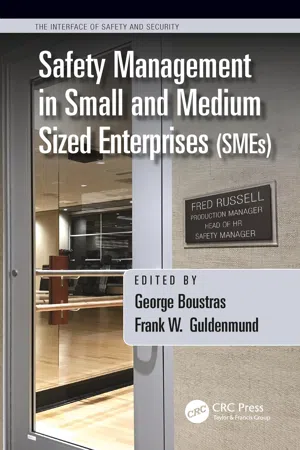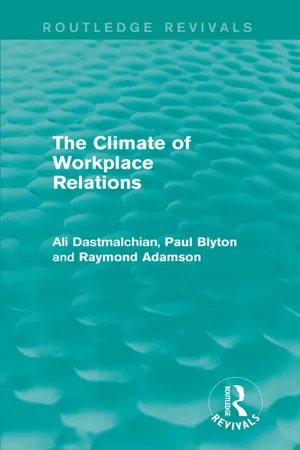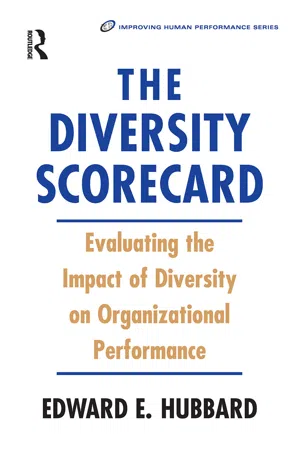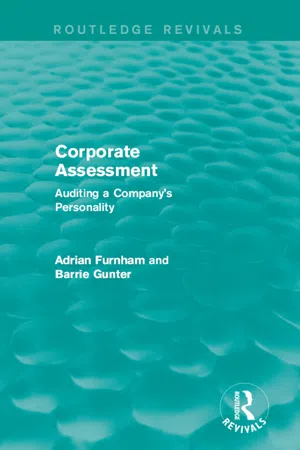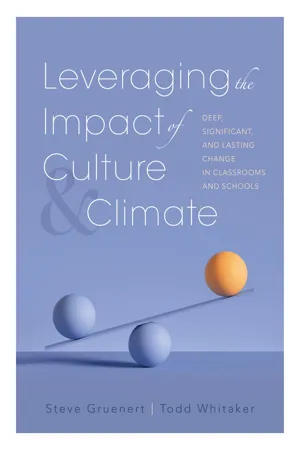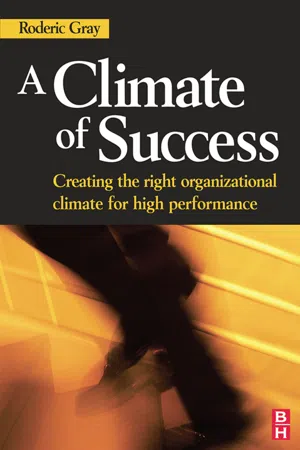Business
Organizational Climate
Organizational climate refers to the prevailing atmosphere, attitudes, and behaviors within a company. It encompasses the overall mood, morale, and culture of the organization, influencing employee satisfaction, productivity, and performance. A positive organizational climate fosters collaboration, innovation, and employee engagement, while a negative climate can lead to dissatisfaction, conflict, and decreased motivation.
Written by Perlego with AI-assistance
Related key terms
Related key terms
1 of 4
Related key terms
1 of 3
10 Key excerpts on "Organizational Climate"
- eBook - ePub
The SAGE Handbook of Industrial, Work & Organizational Psychology
V3: Managerial Psychology and Organizational Approaches
- Deniz S Ones, Neil Anderson, Chockalingam Viswesvaran, Handan Kepir Sinangil, Deniz S Ones, Neil Anderson, Chockalingam Viswesvaran, Handan Kepir Sinangil(Authors)
- 2017(Publication Date)
- SAGE Publications Ltd(Publisher)
9 Organizational Culture and Climate Neal M. Ashkanasy Alana B. Dorris Introduction For decades, researchers have typically managed to confuse the terms ‘organizational culture’ and ‘Organizational Climate', including often using the terms interchangeably. In fact, although the two terms are related, there are clear differences between them (Schneider & Barbera, 2014b). To put it simply, culture is a more intangible concept (involving embedded, agreed upon values and beliefs of an organization's employees), while climate is more tangible and fluctuates based on external factors in the environment. As such, an organization's culture is made up of a set of shared assumptions (Ashforth, 1985), while climate consists of more accessible elements such as behavior and attitude (Drexler, 1977; O'Driscoll & Evans 1988; Moran & Volkwein, 1992). More directly still, culture can be defined as having to do with ‘understanding the systems of meanings, values, and attitudes’ (Ashkanasy, Wilderom, & Peterson, 2000b, p. 8) and a focus on ‘judgments and values', while Organizational Climate focuses more on ‘agreed perceptions of an organizational environment’ (Ashkanasy, 2007, p. 1028). Both organizational culture and Organizational Climate have been central to the field of industrial and organizational psychology since the early works of Lewin (1948, 1951). The terms are dissected in detail in the second edition of the Handbook of Organizational Culture and Climate, a manual representing many of the more recent developments in the field, and edited by Ashkanasy, Wilderom, and Peterson (2011). As in this Handbook, and similar to Ashkanasy and Jackson (2001), we recognize here the transcending and interrelated nature of the constructs of both organizational culture and Organizational Climate - George Boustras, Frank W. Guldenmund(Authors)
- 2017(Publication Date)
- CRC Press(Publisher)
Organizational culture has been defined as ‘a pattern of shared basic assumptions that the group learned as it solved its problems of external adaptation and internal integration, that has worked well enough to be considered valid and, therefore, to be taught to new members as the correct way to perceive, think, and feel in relation to those problems’ (Schein, 1992, p. 12). Thus, organizational culture refers to employees’ normative beliefs and shared behavioural expectations within an organization (Cooke & Szumal, 1993; Glisson & James, 2002). Notably, organizational culture is layered (Hofstede, 1991; Schein, 1992), with shared behavioural expectations and normative beliefs as an outer layer that is conscious to employees, with values and assumptions as an inner layer that is less conscious to employees (Rousseau, 1990; Schein, 1992).Organizational Climate is a related but distinct construct from organizational culture (Denison, 1996; Ostroff, Kinicki, & Muhammad, 2012; Ostroff, Kinicki, & Tamkins, 2003). Organizational Climate is defined as employees’ shared perceptions of organizational policies, procedures and practices (Reichers & Schneider, 1990; Schneider & Reichers, 1983). Organizational Climate provides information regarding what behaviours are rewarded, supported and expected in the workplace (O’Reilly & Chatman, 1996; Schneider & Reichers, 1983), suggesting that climate is one layer of the broader organizational culture construct (Ostroff et al., 2003). Because different domains of organizational life have different policies, procedures and practices, organizations have numerous climates, that is, there is not a singular Organizational Climate, but many climates that are all ‘for’ something (e.g. safety, diversity, service; Schneider & Reichers, 1983). Of all the various types of Organizational Climates, safety climate is one of the most studied (Schneider, Ehrhart, & Macey, 2013).Consistent with the conceptualization of culture as a layered construct differing in the extent to which employees are conscious of them, organizational scholars advocate for assessing culture and climate differently. Culture is determined phenomenologically and qualitatively through observations and interviews, whereas climate is assessed quantitatively through self-reports with a questionnaire (Guldenmund, 2000).- eBook - ePub
The Psychology of Behaviour at Work
The Individual in the Organization
- Adrian Furnham(Author)
- 2012(Publication Date)
- Psychology Press(Publisher)
3 If the Organizational Climate as perceived by members of the focal organization is more favourable than the climate as perceived by members of organizations comprising the organization-set, there will be less innovation because of a reduced motivation to change. Conversely, if the climate as perceived by members of the focal organization is less favourable than the climate as perceived by members of organizations comprising the organization-set, there will be greater innovation.4 Organizational Climate is more susceptible to deliberate efforts to modify it when there is a weak consensus regarding it. As between internal and external Organizational Climate, it is probably easier to alter the former than the latter because of the greater control that the focal organization can exercise over its members than over the members of organizations comprising its organization-set.5 As differences in subunit climates of an organization increase, there is a tendency for greater conflict to arise over proposals for innovation and for a discrepancy to occur in the rate of technical and administrative innovations – that is, for the degree of “organizational lag” to increase.6 Technical innovations, because they are manifested in the products or services of an organization, are more likely to generate faster changes in the external Organizational Climate than administrative innovation. (Evans, 1968: 120–121)Source: Reproduced from Koys & De Cotiis (1991) with the permission of Plenum Publishing Corporation.Table 13.6 Psychological climate dimensionsConclusionCorporate culture is a subtle but pervasive force. Just as various forces (economic, political, religious and ethnic) shape national culture, so various environmental and historical forces influence corporate culture. There are well-established cross-cultural differences in the perception of time, interpersonal space preferred and language used. Organizational culture can be strong or weak depending on the cohesiveness, size and value consensus in the organization. A strong culture is not necessarily a good culture and it may be resistant to change.Corporate culture permits and encourages the shared meanings in every organization. It can be seen in the rites, rituals, myths, legends, symbols, language and artefacts of that culture. Furthermore, it functions to give members an organizational identity, it facilitates collective commitment, it promotes social system stability, and it partly shapes the behaviour of all employees by helping them make sense of their surroundings. For many business people, an adaptable, healthy organizational culture can provide a competitive advantage. Hence, some managers try to develop a specific culture by developing a sense of history, creating a sense of oneness and membership, and increasing exchange among members. - eBook - ePub
The Power of Communication
Managing Information in Public Organizations
- Doris A. Graber(Author)
- 2002(Publication Date)
- CQ Press(Publisher)
Human minds can sense it but it is hard to measure precisely because it leaves few physical traces. 1 Simply defined, climate is the psychological atmosphere members of an organization perceive. Climates have been characterized as hostile or friendly, employee- or management-oriented, sexist, liberating, tense, or relaxed. Such characterizations refer to the atmosphere of an entire system whose boundaries may extend to the whole organization or may be limited to an organizational subunit or even a specific organizational activity. A variety of different climates may prevail in an organization at different times, depending on the nature and pace of its activities and on personnel factors. For example, a laid-back atmosphere may prevail at an Internal Revenue Service branch office following a hectic, high-pressure climate during the spring when most tax returns are filed. Some supervisors may be able to maintain islands of serenity in a subunit, surrounded by a sea of turmoil; others may heighten the sense of pressure. When climates are friendly and supportive or hostile and tense, trusting or mistrusting, these qualities are diffused throughout particular units largely through verbal and nonverbal communication. The end product involves widely shared perceptions, not just one individual’s reactions to the unit or its activities. Questionnaires have been the usual way to ascertain which perceptions are shared by members of an organization. Surveys are often supplemented or replaced by participant-observer techniques borrowed from anthropology or by less formal observations. 2 Because this research focuses on people’s feelings about their environment, measurements are inherently subjective. Climate measurements may involve aggregating individuals’ perceptions of various climate factors or asking them for an overall evaluation of climate conditions. Alternatively, employees may be asked to judge how others in the organization are experiencing the climate - Ali Dastmalchian, Paul Blyton, Ray Adamson(Authors)
- 2014(Publication Date)
- Routledge(Publisher)
Our intention was to create a working model of how climate fitted in to the industrial relations structure and process taking place at the establishment level, and then commence the task of devising a reliable measure of climate and applying this to as wide a range as possible of industrial relations contexts. While we were always aware of the need to take in the influences of head offices and centralizing aspects of industrial relations, our main attention was clearly directed to the workplace arenas where union representatives met management on a day to day basis to conduct industrial relations. In this, our overarching aim was to use climate as a vehicle for understanding in more detail the links between organization and other structures, industrial relations processes, and different industrial relations outcomes.The Climate Concept in Organizational Literature
The concept of Organizational Climate has been widely researched over the past two decades. It has generally been viewed as a variable, or set of variables, that represents the norms, feelings and attitudes prevailing at a workplace (Payne 1971 ; Litwin and Stringer 1968 ). For many writers on Organizational Climate, the concept is seers to comprise the combined perceptions of organizational members describing the atmosphere in their organization. However, even at this general level, several problems are immediately apparent. First, the variety of ways in which the climate concept has been taken up has led to a ‘lack of boundaries differentiating what climate is from what it is not’ (Rousseau 1988 : 140). One way of overcoming this is the way we have adopted: becoming more specific as to the organizational area to which the climate concept is applied (e.g. the climate of union-management: relations).Second, the practice of deriving organizational-level variables (such as ‘Organizational Climate’) by aggregating individual perceptions of climate is not uncontroversial. Indeed, for some writers the issue of aggregation lies at the heart of conceptual and methodological debates on the future direction of research on climate (see, for example,James et al. 1988; and Glick 1988 ). Roberts et al., in their discussion of aggregation problems, argue that two types of data are used in organizational research to describe characteristics of groups and organizations: ‘global data not divisible across individuals (such as organizational ownership) and aggregate data based on some composite of lower level scores’. They go on to argue that, ‘Although both global and aggregate characteristics can be used to describe groups and organizations, the use of aggregate data and concepts makes it more likely that interpreters will be confused and information lost. A future disadvantage is that aggregate data are not directly linked to the level of aggregation about which inferences are made’ (Roberts et al.- eBook - ePub
- Edward Hubbard(Author)
- 2012(Publication Date)
- Routledge(Publisher)
As mentioned in an earlier chapter, making a commitment to diversity means more than striving for immediate results such as improved demographics. Employees must feel welcomed and supported as part of the organization’s climate and culture. They need to know that the organization has systems, processes, and people in place to help give them the best possible chance for success and allow them to build an invigorating career.Collecting Data
Collecting data for the workplace culture/climate index requires examining a variety of sources that will shed light on the organization’s culture and climate. These sources can include some of the following:- Level of organizational commitment from employees
- Aspects of climate
- Aspects of culture
- Employee complaints
- Number of grievances
- Types of discrimination
- Work life initiatives and balance
- Leadership behaviors and practices
- Diversity work team interactions
Let’s examine a few of these sources in more detail. Organizational culture is “the set of shared, taken-for-granted implicit assumptions that a group holds and that determines how it perceives, thinks about, and reacts to its various environments” (Schein, 1996 ). This definition highlights two important characteristics of organizational culture: (1) it influences our behavior at work; and (2) it operates on two levels, which vary in terms of outward visibility and resistance to change.At the less visible level, culture reflects the values shared among organizational members. At Healthco, a UK-based international pharmaceuticals company, the difference between the two levels became very clear when a corporate culture change was implemented. The first part of the change process, focused on behavior (e.g., teamwork, innovation), is extremely well embedded within the organization. The second stage, the issue of a values statement, became far less integrated in the company’s culture (Hope and Hendry, 1995 - eBook - ePub
Corporate Assessment (Routledge Revivals)
Auditing a Company's Personality
- Adrian Furnham, Barrie Gunter(Authors)
- 2015(Publication Date)
- Routledge(Publisher)
Various researchers in the human resources and organizational psychology field have attempted to describe the effect or consequences of Organizational Climate. For instance, Gordon and Cummins (1979) argued that considerable research has showed that various ‘climate’ issues were clearly related to company profit. They listed thirteen:1 The organization has clear goals. 2 The organization has defined plans to meet its goals. 3 The planning system is formal. 4 Planning is comprehensive. 5 Information for decision-making is available. 6 Information for decision-making is used. 7 Good lateral communications exist. 8 Overall communications are good. 9 Units understand each other’s objectives. 10 Clear measures of managerial performance exist. 11 Managers are clear about the results expected of them. 12 Benefits are competitive. 13 Compensation is related to performance.Thus they assert, with some supporting evidence, that if these structural and climatic features occur in an organization it is likely to be profitable. There is no shortage of models or theories explaining, or at least describing, how climate is both the cause and consequence of critical organizational factors. As we shall see there is little agreement between these models, and even less empirical evidence to support them. Campbell et al. (1970) describe the relationship the Organizational Climate has on an organization through the use of the diagram shown in Figure 4.2 .Figure 4.2An expanded picture of the determinants of managerial effectivenessSource: Campbell et al. (1970). Reproduced by permission of the publisher.Organizational Climate is depicted here as having an influence on all aspects of the organization. The manager is involved in all stages in Figure 4.2 - eBook - ePub
Leveraging the Impact of Culture and Climate
Deep, Significant, and Lasting Change in Classrooms and Schools (School Improvement Ideas for Driving Change and Creating a Positive School Culture)
- Steve Gruenert, Todd Whitaker(Authors)
- 2021(Publication Date)
- Solution Tree Press(Publisher)
cultural competence (the ability to understand, appreciate and interact with people from cultures or belief systems different from one’s own; DeAngelis, 2015). Organizational culture is a local phenomenon that occurs when a group of people spend significant time together. They may be close physically or even virtually—whatever environment facilitates the development of a group-based mentality. Each individual member conglomerates his or her values together with others’ values and all members mold them to form a new, teamwide ideology that can be difficult to break through.Even when it comes to something as rigid as religion, different churches in the same denomination can have very different practices. While this may depend on the leadership within individual congregations, influential members, unwritten rules, and social cliques often affect practices—all of which can last far beyond an individual leader.Now, let’s revisit the past to learn how culture and climate became so central to school effectiveness. Looking through educational leadership textbooks from decades past, the topic of culture seems to become more popular with each passing year. In the 1960s, culture might have received a paragraph in a book—then coined as ethos— while now you find whole chapters and even numerous books dedicated to culture. Many books have been published on organizational culture, most of which come from the business and management fields (see anything by former Massachusetts Institute of Technology management professor Edgar H. Schein, starting in 1985). Businesses, organizations, and sports teams all regularly note the impact of culture on their successes or lack thereof. The term culture has become quite vogue in 2021.The world of education validated the concept of culture as a major factor when school effectiveness and school improvement became hot topics in the late 1970s, with works from former Yale University psychology professor emeritus Seymour B. Sarason (1971) and former University of Chicago education professor Dan C. Lortie (1975). The literature began to discriminate between effective cultures and ineffective cultures with writings from University of California Berkeley education policy professor Judith Warren Little (1990), author Susan J. Rosenholtz (1991), and education reform authority Michael Fullan (1997). Then in 1999, coauthors Terrence E. Deal and Kent D. Peterson (1999) provided one of the best books on school culture and how it works (Shaping School Culture: The Heart of Leadership - eBook - ePub
Effective Technology Tools for School Leadership
Understanding Digital and Data-Driven Strategies
- Leslie Jones, Eugene Kennedy(Authors)
- 2022(Publication Date)
- Routledge(Publisher)
Chapter 6 Organizational Culture and Climate DOI: 10.4324/9781003269472-6 Abstract It is widely recognized that the culture and climate of a school have a significant impact on the quality of education provided for students. School culture and climate address shared norms, values, beliefs, and perceptions regarding academics, school safety, and other dimensions (Tichnor-Wagner, Harrison, and Cohen-Vogel, 2016). Many of the levers school leaders utilize to steer schools fall under the umbrella of school culture and climate. As noted by Jones (2009, November), the school leader must monitor the culture and promote positivism in the culture and climate of schools. In this chapter, we discuss the prominence of school culture in professional standards for school leaders and the potential of technology to help school leaders promote and monitor the culture of their schools. The organizational culture and climate of schools impact every facet of schools; and there are many aspects of school culture and climate that are mentioned in the effective schools’ literature (Tichnor-Wagner, Harrison, and Cohen-Vogel, 2016). Instructional leadership and the technology tools to assist school leaders in the role are discussed in Chapter 5, and Jones (2009, November) noted the implications of culture to instructional leadership. We began the chapter with the excerpt from Jones. In 2009, Jones argued that the school leader must monitor the culture and promote positivism in the culture and climate of schools. The article provided below includes culture as a construct of climate. In this chapter, we include the Leadership Standards which are most relevant for culture and climate - eBook - ePub
- Roderic Gray(Author)
- 2007(Publication Date)
- Routledge(Publisher)
theory; the psychological and physiological effects of fear, anger and stress; hostile and extreme work regimes, such as slavery; threat and coercion; motivation; organizational culture; the psychological contract; authority, power and influence; conflict; and attribution theory. From these sources I derived a series of qualitatively testable propositions which led to the identification of eight dimensions of Organizational Climate (and, incidentally, to discarding some others). The final list is:- Free expression of ideas;
- Free expression of concerns;
- Freedom to question (especially decisions and policies determined by more senior people);
- Participation: genuine participation in defining goals and objectives;
- Intrinsic satisfactions derived from the work itself;
- Innovation (freedom to try new concepts and approaches);
- Purposive threat;
- Environmental threat.
These eight dimensions fall into two groups. The first six are positive factors and are largely associated with individual autonomy, responsibility and control. I refer to them collectively as voluntarism. (I’m aware that this term has a rather precise meaning in philosophy, which is related to, but not quite the same as, the meaning I’m ascribing to it here).In general terms the more voluntarism there is the better the climate will feel to most (never all) people in a workplace. However, this is always likely to be a moving target. To illustrate this, Figure 5.2 is based on a principle of customer satisfaction with products or services, which was developed by Professor Noriaki Kano of Tokyo University of Science, modified for this specific application (examples of the Kano method and variations of the Kano diagram are reproduced in many books and articles on product design. For a selection of helpful articles see CQMJ, 1993).Figure 5.2 Three levels of satisfaction (with acknowledgement to N. Kano).In this model, three levels of satisfaction can be distinguished. First, people’s basic expectations must be met, otherwise they will inevitably be dissatisfied to some degree. If their dissatisfaction doesn’t already arise from some specific cause, they will be likely to focus it on some aspect of workplace life which they might otherwise have taken in their stride. Even if basic expectations are fulfilled, there will still be needs that people have from their working life which are unmet. One real difficulty with meeting basic expectations is that they are often unspoken or even unrecognized by the people themselves; it just doesn’t feel right if they are going unmet.
Index pages curate the most relevant extracts from our library of academic textbooks. They’ve been created using an in-house natural language model (NLM), each adding context and meaning to key research topics.
Explore more topic indexes
Explore more topic indexes
1 of 6
Explore more topic indexes
1 of 4

